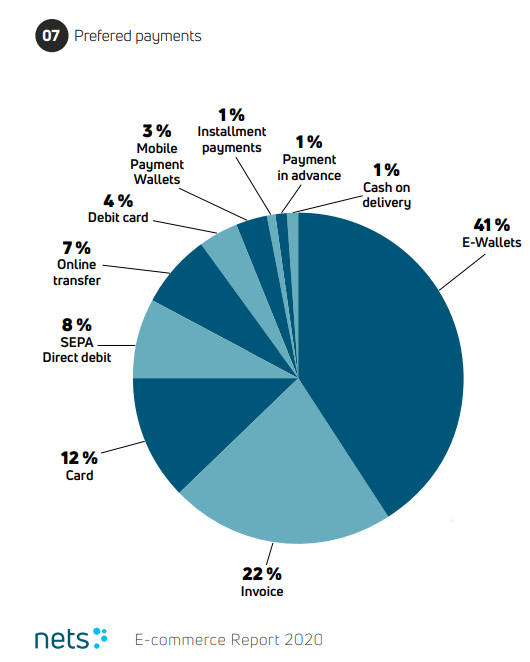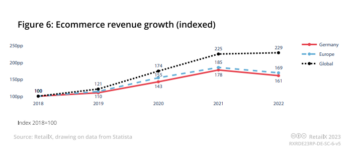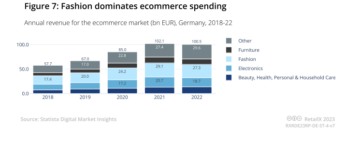Ecommerce in Germany – Ecommerce News

Germany is one of Europe’s strongest economies. With its large population and high internet penetration, it is also one of Europe’s strongest ecommerce markets. In 2022 almost 84 million people live in Germany and 80 percent shops online. German consumers like shopping on marketplaces.
Content:
| GERMANY | COUNTRY | |
| Population | 83.9 million people | |
| – % internet users | 91.4 % | |
| Online sales | €101.7 billion (2022) | |
| Large stores: | Otto, Zalando, Mediamarkt |
Ecommerce events in Germany
Every year there are several ecommerce events being organized in Germany. We have a handy ecommerce events calendar, where you can find all the major online retail events in Europe.
Looking for ecommerce software to start selling in Europe? Webador and Shopify are platforms that are well optimized for cross-border ecommerce.
Ecommerce customers in Germany
PAYMENT METHODS – Traditionally, online shoppers in Germany are keen on using invoice, for years this was their preferred online payment method. But a study from 2020 showed that, among consumers who have a preferred payment method, e-wallets were the most popular choice. PayPal is indeed very popular among Germans. Other popular methods are invoice, credit card, and direct debit.

PRODUCT CATEGORIES – Online fashion is the most popular product category in Germany, followed by consumer media and electronics. Especially in the categories ‘consumer electronics & computers’ and ‘media’ (books, music, movies, video games) German consumers are keener on shopping online instead of shopping offline. According to a study from RetailX, 85 percent of German citizens have shopped online during 2020. And 95 percent of the population has been online that year.
RETURNS – Germany is known for its high return percentage. Some reports claim that 50% of all orders are sent back. This is important to know if you want to do business in Germany.
The German ecommerce market
Fashion dominates spending in the German market. In 2022, 27.3 billion euros of revenue for the ecommerce market was accounting for fashion. With 18.7 billion euros of sales electronics is the next strongest sector in 2022. Growth has slowed in all sectors in 2022, most likely because spending has been impacted by the cost-of-living crisis.
About one in then consumers shop online at least once a day. Around one in four shop online more than once a week and 42 percent shop online more than once a month. Four in ten shoppers spend between 12 and 120 euros a month. Nearly a third spend between 121 and 290 euros a month. 16 percent say they spend between 291 and 590 euros a month.
German consumers like to be informed. Almost half of them research the internet before buying. They consult customers reviews, for example. Also social commerce influence German consumers to purchase. With more than a third of German consumers shopping via social media, the importance of those channels is growing. The most popular platform is Instagram, followed by Facebook.
Big online stores in Germany
Ecommerce in Germany seems all about two big players: American retailer Amazon and German-founded Otto. They own almost half of the online market, so it’s pretty clear that it is quite hard for smaller merchants to make a difference. The current top 10 online stores in Germany are: Amazon (€15.68 billion), Otto (€5.12 billion), MediaMarkt (€2.54 billion), Zalando (€2.52 billion), Ikea (€1.75 billion), Saturn (€1.34 billion), Apple (€1.19 billion), Lidl (€1.02 billion), H&M (€900.2 million), and DocMorris (€783.3 million).
Latest news about Germany
Read all our articles about ecommerce in Germany.
Related
Buy European: a new shopping movement takes hold
As geopolitical tensions intensify following president Trump's return to power, European shoppers are looking to support products from their own continent. Thre
10 Corso Como Unveils Gentle Monster’s First Store in Europe
LANDING IN MILAN: The arrival of Gentle Monster in Milan did not go unnoticed. On Friday night during Milan Fashion Week, the eyewear bran
Climate change protesters occupy Tesla showroom in Westfield shopping mall…
Dozens of climate change protesters occupied the Tesla showroom in Westfield shopping centre on Saturday in the latest misfortune to hit Elon Musk and his elect














